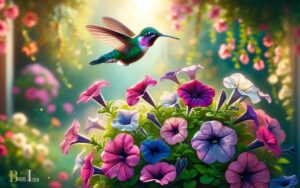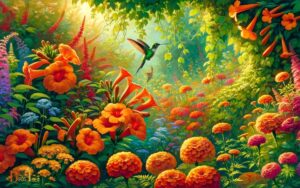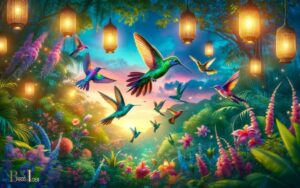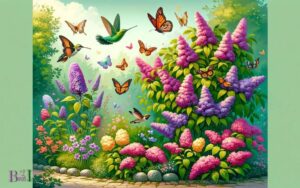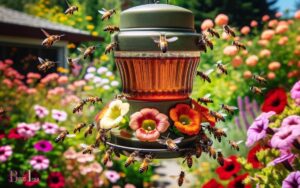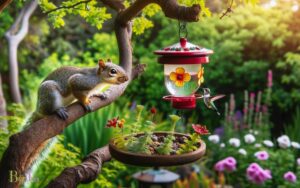Do Fuchsia Plants Attract Hummingbirds? Yes!
Yes, fuchsia plants are known to attract hummingbirds. Their brightly colored flowers and tubular shape are ideal for the feeding habits of these birds.
Fuchsia plants are a popular choice for gardeners looking to attract hummingbirds. The plants typically have vibrant pink, purple, or red flowers that are rich in nectar a primary food source for hummingbirds.
Here are some reasons why fuchsia plants are attractive to hummingbirds:
With their showy blossoms and nectar-rich flowers, fuchsia plants serve as a delightful magnet for the darting, iridescent hummingbirds gracing many gardens.
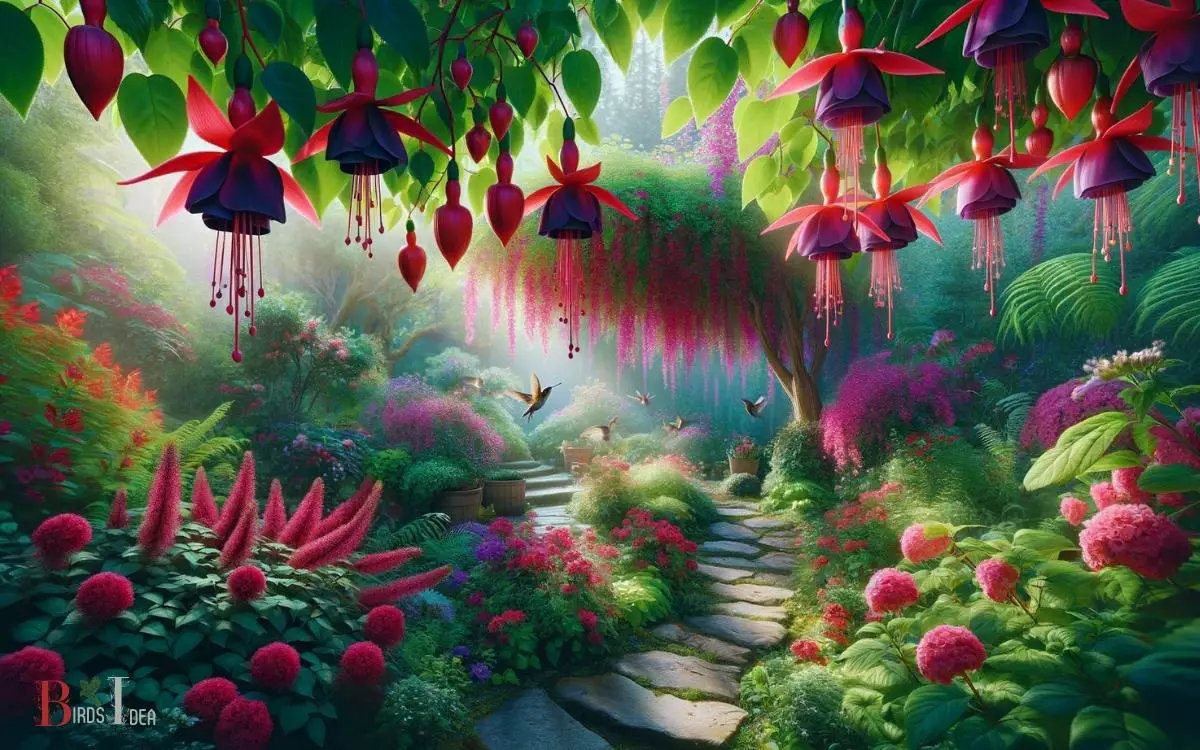
Key Takeaway
Fuchsia Plant Characteristics
The fuchsia plant is known for its distinctive, pendulous flowers that come in a variety of vibrant colors, making it a popular choice for gardeners seeking to attract hummingbirds.
These flowers, which can be found in shades of pink, purple, red, and white, are a significant draw for these tiny, nectar-loving birds.
Fuchsia plants are also characterized by their long blooming period, adding to their appeal for both gardeners and hummingbirds.
The plant’s elegant, tubular flowers are perfectly suited to the hummingbird’s long, slender beak, allowing them to easily access the nectar within.
Moreover, the fuchsia’s ability to thrive in shaded areas further enhances its desirability for gardeners looking to create hummingbird-friendly spaces.
Understanding these characteristics sheds light on why fuchsia plants are so attractive to hummingbirds.
This attractiveness is further evidenced by hummingbird behavior and preferences.
Hummingbird Behavior and Preferences
Hummingbirds are known for their attraction to brightly colored flowers, and fuchsia plants are no exception.
Understanding the color preferences of hummingbirds is essential in determining the likelihood of these birds being attracted to fuchsia plants.
By exploring the relationship between fuchsia plants and the color preferences of hummingbirds, one can gain valuable insights into the behavior and preferences of these fascinating birds.
Fuchsia and Hummingbirds
Fuchsia plants are often sought out by hummingbirds for their nectar-rich flowers, making them a favorite source of sustenance for these vibrant little birds.
Hummingbirds are attracted to fuchsia plants not only for the abundance of nectar but also due to the tubular shape of the flowers, which is well-suited for their long, slender bills and tongues.
These plants provide an important energy source for hummingbirds, especially during migration and breeding seasons.
Additionally, the bright, colorful blooms of fuchsia plants are highly visible to hummingbirds, further attracting them to these flowers.
This mutual relationship benefits both the plants, which are pollinated by the birds, and the hummingbirds, which find a reliable food source.
Understanding the affinity between fuchsia plants and hummingbirds sheds light on the intricate dynamics of their ecosystem and the broader importance of fuchsia in supporting local wildlife.
Color Preferences of Hummingbirds
Evidently, hummingbirds frequently exhibit distinct color preferences when seeking out flowers for nectar, a behavior that reflects their evolutionary adaptations to efficiently locate food sources.
The color preferences of hummingbirds include:
- Red: Hummingbirds are highly attracted to red flowers, as they can perceive the color red more vividly than humans. This preference is an evolutionary trait that has developed due to the abundance of red tubular flowers containing high volumes of nectar.
- Orange: Similar to red, hummingbirds are also drawn to orange flowers. The bright and vibrant hues of orange serve as a visual cue for these birds to locate nectar-rich blooms.
- Pink: While not as preferred as red or orange, pink flowers still catch the attention of hummingbirds, especially if they have a tubular shape and contain ample nectar.
Understanding the color preferences of hummingbirds is crucial for gardeners and conservationists aiming to attract and support these remarkable birds.
Flower Color and Shape
Flower color and shape play a crucial role in attracting hummingbirds to fuchsia plants. Hummingbirds are attracted to bright and vivid colors such as red, pink, and orange, which are commonly found in fuchsia flowers.
The tubular shape of fuchsia flowers is also perfectly suited to the long, slender bills of hummingbirds, allowing them to easily access the nectar inside.
The shape of the flower allows the hummingbirds to hover and sip nectar, fulfilling their high-energy needs.
Additionally, the pendulous nature of fuchsia flowers provides a natural shelter for the birds, offering protection and privacy while they feed.
These factors make fuchsia plants with their vibrant, tubular flowers a magnet for hummingbirds seeking sustenance and shelter.
Nectar Production and Availability
Fuchsia plants are known for their high nectar production, making them a valuable food source for hummingbirds.
Understanding the relationship between fuchsia nectar attraction and hummingbird feeding behavior can provide insights into nectar plant selection.
This discussion will shed light on the specific factors that make fuchsia plants a preferred choice for hummingbirds seeking nectar.
Fuchsia Nectar Attraction
Nectar production and availability play a crucial role in attracting hummingbirds to fuchsia plants. Fuchsia plants produce abundant nectar, which is a major draw for hummingbirds.
The availability of nectar is essential for sustaining these tiny birds, making fuchsia plants a favored food source for them.
Here’s why fuchsia nectar is so enticing to hummingbirds:
- High Sugar Content: Fuchsia nectar is rich in sucrose, providing a high-energy source for hummingbirds.
- Abundant Nectar: Fuchsia plants produce a consistent and plentiful supply of nectar, ensuring that hummingbirds have a reliable food source.
- Attractive Color: The bright and vibrant hues of fuchsia flowers are visually appealing to hummingbirds, making them more likely to investigate and feed on the nectar.
Understanding these factors can help gardeners attract and support hummingbirds in their outdoor spaces.
Garden Placement and Environment
Fuchsia plants thrive in well-drained, partially shaded garden environments, making them an ideal choice for attracting hummingbirds.
When considering garden placement, it’s important to select an area with dappled sunlight or partial shade, as this mimics their natural habitat.
Placing fuchsia plants under the canopy of trees or near taller shrubs can provide the right amount of shade while still allowing some sunlight to filter through.
Additionally, ensuring that the soil is well-drained is crucial for the overall health of the fuchsia plants.
Hummingbirds are also attracted to areas with diverse plant life, so incorporating a variety of nectar-rich flowers alongside the fuchsia plants can further enhance the appeal of the garden to these delightful birds.
Tips for Attracting Hummingbirds with Fuchsia Plants
Attracting hummingbirds with fuchsia plants can be a delightful and rewarding experience. Hummingbirds are attracted to the bright colors, tubular flowers, and nectar-rich blooms that fuchsias provide.
Here are some tips to maximize the chances of attracting hummingbirds to your fuchsia plants:
- Choose the Right Fuchsia Variety: Opt for fuchsia varieties with long, tubular flowers, as these are more appealing to hummingbirds. Some popular varieties include Fuchsia magellanica and Fuchsia triphylla.
- Select Brightly Colored Flowers: Hummingbirds are attracted to bright colors, especially red and pink. Choose fuchsia varieties with vibrant, eye-catching blooms to catch their attention.
- Plant in the Right Location: Place your fuchsia plants in a location that receives partial shade. Hummingbirds prefer areas with a mix of sunlight and shade, and this will also help prevent the plants from drying out.
- Provide Adequate Sunlight: While partial shade is preferred, fuchsia plants still need a good amount of sunlight. Ensure they receive at least 4-6 hours of indirect sunlight daily.
- Keep Soil Moist: Hummingbirds are attracted to flowers with abundant nectar. Keep the soil consistently moist but well-drained to promote healthy flower production and nectar production.
- Use Hummingbird-Friendly Fertilizers: Avoid excessive use of nitrogen-rich fertilizers, as they can encourage lush foliage but fewer flowers. Opt for a balanced fertilizer or one specifically formulated for flowering plants.
- Regular Pruning: Prune your fuchsia plants regularly to encourage branching and more flower production. This will provide more opportunities for hummingbirds to feed.
- Provide Perches: Hummingbirds need perches to rest between feeding. Place small branches or stakes near your fuchsia plants where hummingbirds can perch and survey the area.
- Maintain Clean Feeders: If you have hummingbird feeders in addition to fuchsia plants, ensure they are kept clean and filled with fresh nectar. Hummingbirds may visit both the feeders and the fuchsia plants for a varied food source.
- Avoid Pesticides: Minimize the use of pesticides in your garden, as hummingbirds may be deterred by chemicals. Opt for natural or organic pest control methods to keep the garden hummingbird-friendly.
- Provide Year-Round Blooms: Choose fuchsia varieties that bloom throughout the growing season. This ensures a continuous source of nectar for hummingbirds.
By incorporating these tips, you can create an inviting environment for hummingbirds and enjoy the beauty of these fascinating creatures in your garden.
Conclusion
Fuchsia plants are known to attract hummingbirds due to their vibrant colors, unique shape, and abundant nectar production.
By strategically placing these plants in a garden environment, individuals can create an inviting space for these beautiful birds to visit and enjoy.
So, whether you’re a seasoned gardener or just starting out, consider adding fuchsia plants to your garden and see the magic unfold as hummingbirds flock to your space.

